|
|
 |
Artemisia Gentileschi
|
|
Italian
1593-1652
Artemisia Gentileschi Gallery
Gentileschi was born on July 8, 1593 in Rome. She was the daughter of the painter Orazio Gentileschi and was trained by him. Our perception of Gentileschi has been colored by the legend surrounding her. Her alleged rape by her father colleague, the quadratura painter Agostino Tassi, when she was 17, was the subject of a protracted legal action brought by Orazio in 1611. Although she was subsequently married off to Pietro Antonio di Vicenzo Stiattesi in 1612 and gave birth to at least one daughter, she soon separated from her husband and led a strikingly independent life for a woman of her time - even if there is no firm evidence for the reputation she enjoyed in the 18th century as a sexual libertine. After her marriage, Gentileschi lived in Florence until about 1620. She then worked in Genoa and settled in Naples in 1630. Gentileschi traveled to England in 1638-40, where she collaborated with her father on a series of canvasses for the Queen House, Greenwich (now Marlborough House, London). Gentileschi died in Naples in 1652.
It is tempting to adduce the established biographical data in partial explanation of the context of her art: the sympathy and vigor with which she evokes her heroines and their predicaments, and her obsession with that tale of female triumph, Judith and Holofernes. But such possibilities should not distract attention from the high professional standards that Gentileschi brought to her art. In a letter, dated July 3, 1612, to the Grand Duchess of Tuscany, Orazio claimed that "Artemisia, having turned herself to the profession of painting, has in three years so reached the point that I can venture to say that today she has no peer. Despite the obvious exaggeration, one can agree that Gentileschi art was of a consistently high quality virtually from the beginning.
|
|
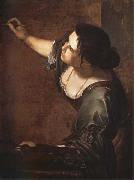 |
Artemisia gentileschi
|
|
1593-1652
was an Italian Early Baroque painter, today considered one of the most accomplished painters in the generation influenced by Caravaggio. In an era when women painters were not easily accepted by the artistic community, she was the first female painter to become a member of the Accademia di Arte del Disegno in Florence. She was one of the first female artists to paint historical and religious paintings, at a time when such heroic themes were considered beyond a woman's reach. Artemisia Gentileschi was born in Rome, July 8, 1593, the first child of the Tuscan painter Orazio Gentileschi, one of the best representatives of the school of Caravaggio. Artemisia was introduced to painting in her father's workshop, showing much more talent than her brothers, who worked alongside her. She learned drawing, how to mix color and how to paint. Since her father's style took inspiration from Caravaggio during that period, her style was just as heavily influenced in turn. But her approach to subject matter was different from her father's, as her paintings are highly naturalistic, where Orazio's are idealized. The first work of the young 17-year-old Artemisia (even if many at the time suspected that she was helped by her father) was the Susanna e i Vecchioni (Susanna and the Elders) (1610, Schönborn collection in Pommersfelden). The picture shows how Artemisia assimilated the realism of Caravaggio without being indifferent to the language of the Bologna school (which had Annibale Carracci among its major artists). It is one of the few Susanna paintings showing the two men planning their sexual harassment. It is likely that Artemisia had been sexually harrassed and painted Susanna as a reflection. In 1612, despite her early talent, Artemisia was denied access to the all-male professional academies for art. At the time, her father was working with Agostino Tassi to decorate the vaults of Casino della Rose inside the Pallavicini Rospigliosi Palace in Rome, so Orazio hired the painter to tutor his daughter privately. During this tutelage, Tassi raped Artemisia. Another man, Cosimo Quorlis had helped Tassi with the rape. After the initial rape, Artemisia continued to have sexual relations with Tassi, with the expectation that they were going to be married. However, Tassi reneged on his promise to marry Artemisia after he heard the rumor that she was having an affair with another man. Quorlis had threatened that if he could not have her, he would publicly humiliate her. Orazio pressed charges against Tassi only after he learned that Artemisia and Tassi were not going to be married. Orazio also claimed that Tassi stole a painting of Judith from the Gentileschi household. The major issue of this trial was the fact that Tassi had deflowered Artemisia. If Artemisia had not been a virgin before Tassi raped her, the Gentileschis would not be able to press charges. In the ensuing 7-month trial, it was discovered that Tassi had planned to murder his wife, had enjoined in adultery with his sister-in-law and planned to steal some of Orazio??s paintings. During the trial Artemisia was given a gynecological examination and was tortured using a device made of thongs wrapped around the fingers and tightened by degrees ?? a particularly cruel torture to a painter. Both procedures were used to corroborate the truth of her allegation, the torture device used due to the belief that if a person can tell the same story under torture as without it, the story must be true. At the end of the trial Tassi was imprisoned for one year. The trial has subsequently influenced the feminist view of Artemisia Gentileschi during the late 20th century. The painting Giuditta che decapita Oloferne (Judith beheading Holofernes) (1612 - 1613), displayed in the Capodimonte Museum of Naples, is impressive for the violence portrayed, and has been interpreted as a wish for psychological revenge for the violence Artemisia had suffered. One month after the trial, in order to restore her honor, Orazio arranged for his daughter to marry Pierantonio Stiattesi, a modest artist from Florence. Shortly afterwards the couple moved to Florence, where Artemisia received a commission for a painting at Casa Buonarroti and became a successful court painter, enjoying the patronage of the Medici family and Charles I. It has been proposed that during this period Artemisia also painted the Madonna col Bambino (The Virgin and Child), currently in the Spada Gallery, Rome. While in Florence, |
|
|
|
|
|
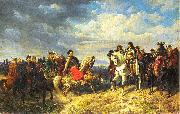 |
Artur Grottger
|
|
(1837 - 1867) was a Polish painter and graphic designer, one of the most prominent artists of the early 1800s despite his brief life.
He was born in Eastern Galicia to an amateur artist of German background, Jan Jozef Grottger, and a Polish mother. Grottger studied painting under the apprenticeships of Jan Kanty Maszkowski and Juliusz Kossak in Lwew. Grottger received an imperial scholarship to attend the Krakow School of Fine Arts, where he studied under Władysław Łuszczkiewicz and Wojciech Kornel Stattler. Around this time he met one of his biggest future art patrons and benefactors, Aleksander Pappenheim.
Grottger painted mostly epic battle scenes. He moved to Vienna in 1854, where he produced some of his most famous paintings. In 1865, Grottger returned to Poland and stayed in Krakew and Lwew, but left this time for good in 1866. |
|
|
|
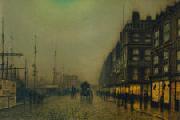 |
Atkinson Grimshaw
|
|
British
1836-1893
Atkinson Grimshaw Gallery
Grimshaw's primary influence was the Pre-Raphaelites. True to the Pre-Raphaelite style, he put forth landscapes of accurate color and lighting, and vivid detail. He often painted landscapes that typified seasons or a type of weather; city and suburban street scenes and moonlit views of the docks in London, Leeds, Liverpool, and Glasgow also figured largely in his art. By applying his skill in lighting effects, and unusually careful attention to detail, he was often capable of intricately describing a scene, while strongly conveying its mood. His "paintings of dampened gas-lit streets and misty waterfronts conveyed an eerie warmth as well as alienation in the urban scene."
Dulce Domum (1855), on whose reverse Grimshaw wrote, "mostly painted under great difficulties," captures the music portrayed in the piano player, entices the eye to meander through the richly decorated room, and to consider the still and silent young lady who is meanwhile listening. Grimshaw painted more interior scenes, especially in the 1870s, when he worked until the influence of James Tissot and the Aesthetic Movement.
On Hampstead Hill is considered one of Grimshaw's finest, exemplifying his skill with a variety of light sources, in capturing the mood of the passing of twilight into the onset of night. In his later career this use of twilight, and urban scenes under yellow light were highly popular, especially with his middle-class patrons.
His later work included imagined scenes from the Greek and Roman empires, and he also painted literary subjects from Longfellow and Tennyson ?? pictures including Elaine and The Lady of Shalott. (Grimshaw named all of his children after characters in Tennyson's poems.)
In the 1880s, Grimshaw maintained a London studio in Chelsea, not far from the comparable facility of James Abbott McNeill Whistler. After visiting Grimshaw, Whistler remarked that "I considered myself the inventor of Nocturnes until I saw Grimmy's moonlit pictures."[9] Unlike Whistler's Impressionistic night scenes, however, Grimshaw worked in a realistic vein: "sharply focused, almost photographic," his pictures innovated in applying the tradition of rural moonlight images to the Victorian city, recording "the rain and mist, the puddles and smoky fog of late Victorian industrial England with great poetry."
Some artists of Grimshaw's period, both famous and obscure, generated rich documentary records; Vincent Van Gogh and James Smetham are good examples. Others, like Edward Pritchett, left nothing. Grimshaw left behind him no letters, journals, or papers; scholars and critics have little material on which to base their understanding of his life and career.
Grimshaw died 13 October 1893, and is buried in Woodhouse cemetery, Leeds. His reputation rested, and his legacy is probably based on, his townscapes. The second half of the twentieth century saw a major revival of interest in Grimshaw's work, with several important exhibits of his canon. |
|
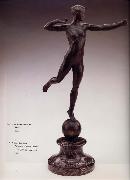 |
Augustus Saint-Gaudens
|
|
Irish-born American Realist Sculptor, 1848-1907, He was the Irish-born American sculptor of the Beaux-Arts generation who most embodied the ideals of the "American Renaissance." Raised in New York City, he traveled to Europe for further training and artistic study, and then returned to major critical success in the design of monuments commemorating heroes of the American Civil War, many of which still stand. In addition to his famous works such as the Robert Gould Shaw Memorial on Boston Common and the outstanding grand equestrian monuments to Civil War generals John A. Logan, atop a tumulus in Chicago, 1894-97 |
|
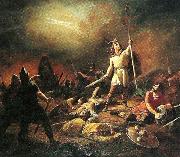 |
axel gustaf hertzberg
|
|
1832-1878
Axel Gustaf Hertzberg född 27 augusti 1832 i Jämtland, död 2 september 1878 i Dusseldorf , Tyskland var en svensk bildkonstnär.
Hertzberg ägnade sig först åt porträtteckning och litografi men övergick senare till oljemåleri. Han studerade vid konstakademien i Stockholm 1849-1860. Han gjorde en resa till Finland där han stannade två år. Därefter studerade han konst i Paris, och slutligen Dusseldorf.
Hertzberg blev 1867 agre vid konstakdemien i Stockholm. |
|
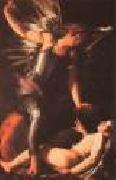 |
BAGLIONE, Giovanni
|
|
Italian Baroque Era Painter, active 1573-1644
A pupil of Francesco Morelli, he worked mainly in Rome, initially with a late-Mannerist style. He was also nicknamed Il Sordo del Barozzo. He published two books, The nine churches of Rome (1639) and The Lives of Painters, Sculptors, Architects and Engravers (active from 1572-1642)(1642). The last title is still seen as an important historical source for painters living in Rome during the life of Baglione.
Among those he chronicled, and for whom he was notorious in his animosity was Caravaggio, whose style had influenced him much. The latter was forced to leave the city after Baglione's accusations of sodomy. Baglione's Sacred love versus profane love, a response to Caravaggio's Love Victorious, shows an angel (Sacred Love) interrupting a 'meeting' between Cupid (Profane Love) and the Devil (portrayed with the face of Caravaggio).
He was employed in many considerable works in Rome during the pontificates of Clement VIII and Paul V. His main works are frescoes which can be seen in the Santa Maria Maggiore in Rome, in the Cappella Borghese. For the church of Santa Maria dell'Orto he painted in the chapel of Our Lady with the Zuccheri scenes from the life of the Blessed Virgin. Among other works which he executed for this church is a painting of Saint Sebastian. An excellent example of Baglione's work is The Last Supper at San Nicola in Carcere. From his brush also there is a Saint Stephen in the Cathedral at Perugia, and in that of Loreto a Saint Catherine. Pope Paul V knighted Baglione a Knight of the Order of Christ for his painting of Saint Peter Raising Tabitha from the Dead (1607) in St. Peter's Basilica. He also painted a St. Stephen for the cathedral of Perugia, and a St. Catharine for the cathedral of Loreto. The Giustizia hall at the Rocca dei Rossi was completely frescoed by Baglione. He died at Rome. |
|
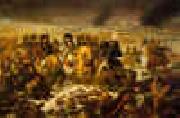 |
Baron Antoine-Jean Gros
|
|
1771-1835
French
Baron Antoine-Jean Gros Galleries
The son of a painter, Antoine Jean Gros was born in Paris on March 16, 1771. At the age of 14 he entered the studio of Jacques Louis David, the acknowledged leader of the classical revival. Although his own work became radically different from David's, he maintained a lifelong respect for his teacher and envisioned himself as the upholder of the Davidian tradition.
In 1787 Gros entered the Acad??mie de Peinture, and when the Acad??mie dissolved in 1793 (a result of the French Revolution) he went to Italy. He met Josephine Bonaparte in Genoa in 1796, and she introduced him to Napoleonic society. Gros entered Napoleon's immediate entourage and accompanied him on several north Italian campaigns. Gros also became involved with Napoleon's program of confiscating Italian art for removal to France.
Gros returned to Paris in 1800 and began to show his Napoleonic paintings in the annual Salons. The most famous of these are the Pesthouse at Jaffa (1804) and Napoleon at Eylau (1808). These works served to deify Napoleon, showing him engaged in acts of heroism and mercy. Stylistically, the paintings were revolutionary:their exotic settings, rich color, agitated space, and general penchant for showing the gruesome specifics of war and suffering differed radically from the cool generalizations of Davidian classicism that Gros had learned as a student. The presentation of contemporary historical events was also new, a harbinger of the realism that developed steadily during the first half of the 19th century in French, American, and English painting. Finally, the emphatic emotionalism of Gros's art established the foundation of romantic painting that Th??odore G??ricault and Eug??ne Delacroix developed after him.
Unlike that of some of his countrymen (David is a case in point), Gros's position did not suffer after the fall of Napoleon. Gros painted for the restored monarchy, for instance, Louis XVIII Leaving the Tuileries (1817), and he decorated the dome of the Panth??on in Paris with scenes of French history (1814-1824). For this Charles X made him a baron in 1824. But these works lack the zest and commitment of Gros's Napoleonic period, perhaps because they were not based on the immediate kinds of historical experiences that had inspired the earlier paintings.
Although marked by considerable public success, Gros's later career was in many ways acutely troubled. Basically, he could not resolve his personal esthetic theories with his own painting or with the work of his younger contemporaries. To the end Gros wished to propagate the classicism of David, and he took over David's studio when the master was exiled in 1816. By the 1820s, however, the revolutionary romanticism of G??ricault and Delacroix, among others, had clearly begun to eclipse classicism, and Gros found himself fighting a lonely and losing battle for conservatism. Ironically, he was fighting a trend that his own best work had helped to originate. As he persisted, moreover, his own painting began to show a diffident mixture of classic and romantic attitudes. Thus, while he was inherently a romantic, he tragically came to doubt himself. Gros died on June 26, 1835, apparently a suicide. |
|
 |
Baron Francois Gerard
|
|
1770-1837
French
Baron Francois Gerard Galleries
French portrait and historical painter, b. Rome. In Paris, after brief study under Pajou and others, he became a favorite pupil of J. L. David, who influenced such works as Psyche Receiving the Kiss of Cupid and Daphnis and Chloe, both in the Louvre. As a leading portraitist, Gerard was patronized by the court during the Empire and the Bourbon restoration. His portrait of Mme Recamier, of this period, is in the Louvre. Louis XVIII appointed him court painter in 1814. Many examples of his historical paintings are in the Versailles Museum. His portrait of the Countess Regnault de Saint-Jean-d Angely (1798; Louvre) exemplifies his style of studied elegance and meticulous finish. |
|
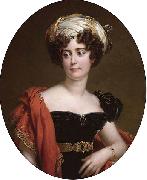 |
Baron Gerard
|
|
There have been three baronies created for descendants of the Gerard family who resided at Bryn, Ashton in Makerfield, Lancashire and Kingsley, Cheshire in the 13th century.
The title Baron Gerard of Gerards Bromley, was created in the Peerage of England on 21 July 1603 for Sir Thomas Gerard (d. 1617), son of Sir Gilbert Gerard (d. 1593) Attorney General between 1559 and 1581 and Master of the Rolls in 1581, who acquired estates at Gerards Bromley and Hilderstone, Staffordshire. The first Baron was Lord President of Wales between 1610 and 1617. The barony passed in direct line of succession until the death of the fifth Baron in 1684 when it passed to his second cousin Charles, and upon his death without a male heir , to his brother Philip Gerard, a Jesuit priest who died childless in 1773 when the barony expired.
The title of Baron Gerard of Bryn in the County Palatine of Lancaster, was created in the Peerage of the United Kingdom in 1876 for Sir Robert Gerard, 13th Baronet. The title followed the line of the first Baron's eldest son until the death of the latter's grandson, the fourth Baron, in 1992. He was succeeded by his second cousin once removed, the fifth and present holder of the barony. He is the great grandson of Captain the Hon. Robert Joseph Gerard-Dicconson, second son of the first Baron.
A Gerard Baronetcy had been created in the Baronetage of England in 1611 for Thomas Gerard, Member of Parliament for Liverpool, Lancashire, and Wigan who was a direct descendant of the family of Bryn. He was succeeded by his son, the second Baronet. He also represented Liverpool in the House of Commons. His son, the third Baronet, was a Royalist during the Civil War and spent a large part of his estate in in his support for King Charles I. His great-great-great-grandson was the aforementioned thirteenth Baronet, who was elevated to the peerage in 1876.
For the title Baron Gerard of Brandon, in the County of Suffolk, created in 1645 for a great-grandson of Sir Gilbert Gerard (mentioned above), see Earl of Macclesfield.
|
|
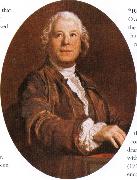 |
baron grimm
|
|
German critic. He worked as a diplomat in Paris from 1749. Influenced by the Encyclopedists, he favoured the use of the Italian style in French operas (especially those of Rameau); in the Querelle des Bouffons of the 1750s he rejected all French music in favour of Rousseau, writing the satirical tract Le petit proph??te de Boehmischbroda (1753) and other works. He was a friend to the visiting Mozart family, 1763-4 and 1778.
|
|
 |
Baron Pierre Narcisse Guerin
|
|
Paris 1774-Rome 1833
French painter. He won enthusiastic recognition in 1799 for his Marius Sextus (Louvre). A defender of the classicism of J. L. David, he became director of the École de Rome in 1822. He counted among his pupils Delacroix, G??ricault, and Ary Scheffer, who were to launch the romantic school. |
|
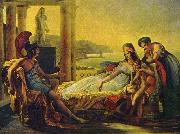 |
Baron Pierre-Narcisse Guerin
|
|
(13 May 1774 - 6 July 1833) was a French painter.
Guerin was born in Paris.
A pupil of Jean-Baptiste Regnault, he carried off one of the three grands prix offered in 1796, in consequence of the competition not having taken place since 1793. In 1799, his painting Marcus Sextus (Louvre) was exhibited at the Salon and excited wild enthusiasm. Part of this was due to the subject - a victim of Sulla's proscription returning to Rome to find his wife dead and his house in mourning - in which an allusion was found to the turmoil of the French Revolution.
Guerin on this occasion was publicly crowned by the president of the Institute, and went to Rome to study under Joseph-Benoît Suvee. In 1800, unable to remain in Rome on account of his health, he went to Naples, where he painted the Grave of Amyntas. In 1802 Guerin produced Phaedra and Hippolytus (Louvre); in 1810, after his return to Paris, he again achieved a great success with Andromache and Pyrrhus (Louvre); and in the same year also exhibited Cephalus and Aurora (Louvre) and Bonaparte and the Rebels of Cairo (Versailles). These paintings suited the popular taste of the First Empire, being highly melodramatic and pompously dignified.
The Restoration brought to Guerin fresh honours; he had received from the first consul in 1803 the cross of the Legion of Honour, and in 1815 Louis XVIII named to the Academie des Beaux-Arts. His style changed to accord with popular taste. In Aeneas Relating to Dido the Disasters of Troy (Louvre), Guerin adopted a more sensuous, picturesque style.
Guerin was commissioned to paint for the Madeleine a scene from the history of St Louis, but his health prevented him from accomplishing what he had begun, and in 1822 he accepted the post of director of the French Academy in Rome, which in 1816 he had refused. On returning to Paris in 1828, Guerin, who had previously been made chevalier of the order of St. Michel, was ennobled. He now attempted to complete Pyrrhus and Priam, a work which he had begun at Rome, but in vain; his health had finally broken down, and in the hope of improvement he returned to Italy with Horace Vernet. Shortly after his arrival at Rome Baron Guerin died, on the 6th of July 1833, and was buried in the church of La Trinite de Monti by the side of Claude Lorrain.
|
|
 |
bartolomeo della gatta
|
|
(1448 -1502), born Pietro di Antonio Dei, was an Italian (Florentine) painter, illuminator, and architect. He was the son of a goldsmith. He was a colleague of Fra Bartolommeo. In 1468, Bartolomeo became a monk in the Order of Camaldoli, probably in the Church of Santa Maria degli Angeli in Florence, which his brother Nicolo had already entered. Upon taking holy orders, he changed his name to Bartolomeo. About 1481, he was summoned to Rome where he contributed to the cycle of frescos on the walls of the Sistine Chapel. Bartolomeo eventually became Abbot of San Clemente in Arezzo. He died in 1502 and was buried in the Abbey of San Clemente.
|
|
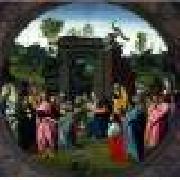 |
BARTOLOMEO DI GIOVANNI
|
|
Italian Early Renaissance Painter, active 1475-1511
Bartolomeo di Giovanni, also known as Bartolommeo di Giovanni and as Alunno di Domenico, was an early renaissance Italian painter of the Florentine School who was active from about 1480 until his death in 1501. He studied with and assisted Domenico Ghirlandaio, painting the predella of Ghirlandaio's Adoration of the Magi in the Ospedale degli Innocenti (Foundling Hospital) in Florence, in 1488. Bartolomeo di Giovanni also worked under the guidance of Sandro Botticelli. |
|
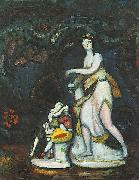 |
Bela Ivanyi-Grunwald
|
|
(6 May 1867 - 24 September 1940) was a Hungarian painter, a leading member of the Nagybenya artists' colony and founder of the Kecskemet artists' colony.
Born in Som, Ivenyi-Grenwald began his artistic studies under Bertalan Szekely and Keroly Lotz at the Academy of Fine Arts in Budapest (1882-86) and continued them at Munich in 1886-87 and at the Academie Julian in Paris from 1887 to 1890. From 1891 he again worked in Munich; in 1894 he travelled with Ferenc Eisenhut to Egypt, where he painted several oriental-themed works. Beginning in 1889 he had regular exhibitions at the Palace of Art in Budapest. Characteristic of his early pictures is A Hader kardja ("The Warrior's Sword", 1890), a proto-Symbolist treatment of rural genre showing the influence of Jules Bastien-Lepage. After his return to Munich, Ivenyi-Grenwald painted a large-scale genre painting entitled Nihilistek sorsot heznak ("Nihilists Drawing Lots", 1893), a work as notable for its dramatic use of chiaroscuro as for its deeply felt subject-matter. In response to a state commission for the 1896 Millennium Exhibition in Budapest he produced an enormous academic history painting. |
|
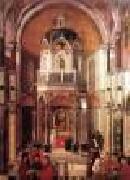 |
BELLINI, Gentile
|
|
Italian Early Renaissance Painter, ca.1429-1507
Gentile was born into a family of renowned painters: his father Jacopo Bellini, was a Venetian pioneer in the use of oil paint as an artistic medium; his acclaimed brother was Giovanni Bellini, and his brother-in-law Andrea Mantegna. Gentile was taught painting in the workshop of his father. Although today Gentile is often seen in the shadow of his more famous family members, in his own time he was considered among the greatest living painters in Venice and had no shortage of commissions; his talent as a portraitist revealed itself at an early age. |
|
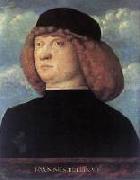 |
BELLINI, Giovanni
|
|
Italian High Renaissance Painter, ca.1430-1516
Giovanni Bellini (c. 1430 ?C 1516) was an Italian Renaissance painter, probably the best known of the Bellini family of Venetian painters. His father was Jacopo Bellini, his brother was Gentile Bellini, and his brother-in-law was Andrea Mantegna. He is considered to have revolutionized Venetian painting, moving it towards a more sensuous and colouristic style. Through the use of clear, slow-drying oil paints, Giovanni created deep, rich tints and detailed shadings. His sumptuous coloring and fluent, atmospheric landscapes had a great effect on the Venetian painting school, especially on his pupils Giorgione and Titian. |
|
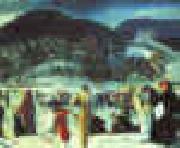 |
Bellows, George
|
|
American, 1882-1925.American painter and lithographer. He was the son of George Bellows, an architect and building contractor. He displayed a talent for drawing and for athletics at an early age. In 1901 he entered Ohio State University, where he contributed drawings to the school yearbook and played on both the basketball and baseball teams. In spring of his third year he withdrew from university to play semi-professional baseball until the end of summer 1904; |
|
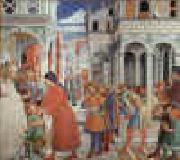 |
Benozzo Gozzoli
|
|
Italian Early Renaissance Painter, 1420-1497
Italian Renaissance painter. Early in his career he assisted Lorenzo Ghiberti on the east doors of the Baptistery in Florence and Fra Angelico on frescoes in Florence, Rome, and Orvieto. His reputation today rests on the breathtaking fresco cycle The Journey of the Magi (1459 ?C 61) in the chapel of Florence's Medici-Riccardi Palace. His work as a whole was undistinguished, however. He painted several altarpieces and a series of 25 frescoes of Old Testament scenes, now badly damaged, for the Camposanto in Pisa (1468 ?C 84).
|
|
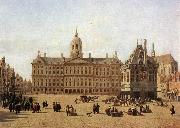 |
BERCKHEYDE, Gerrit Adriaensz.
|
|
Dutch Baroque Era Painter, 1638-1698
Brother of Job Berckheyde. Gerrit specialized in a particular type of architectural subject, the TOWNSCAPE. His painted work shows a debt not only to Pieter Saenredam's conception of the building portrait but also to Saenredam's refined draughtsmanship and dispassionate attitude; these qualities mark Berckheyde as a classicist and akin to Vermeer. Berckheyde favoured views of monuments on large open squares, a choice that distinguishes him from the other great Dutch townscape painter, Jan van der Heyden, who preferred views along canals in which clarity was sacrificed for pictorial effect. |
|
|
|
 |
Bingham, George Caleb
|
|
American Realist Painter, 1811-1879. American painter. Raised in rural Franklin County, MO, Bingham experienced from an early age the scenes on the major western rivers, the Missouri and the Mississippi, that inspired his development as a major genre painter. During his apprenticeship to a cabinetmaker, he met the itinerant portrait painter Chester Harding, who turned Bingham's attention to art. Teaching himself to draw and compose from art instruction books and engravings, the only resources available in the frontier territories, Bingham began painting portraits as early as 1834. |
|
|
|
|
|
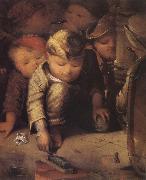 |
Blythe David Gilmour
|
|
American Painter, 1815-1865
He began his career as an itinerant portrait painter in the early 1840s and became one of the leading satirical artists in America by the beginning of the Civil War. Self-taught, from 1840 to 1850 he worked in East Liverpool, OH, and Uniontown, PA, and nearby towns and villages, painting rather stiff likenesses of the local gentry. He also carved a monumental polychrome wooden statue of Marie-Joseph, Marquis de Lafayette for the Uniontown courthouse and painted a landscape panorama of the Allegheny mountains, which he took on tour through Maryland, Pennsylvania and Ohio. |
|
|
|
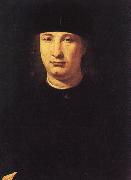 |
BOLTRAFFIO, Giovanni Antonio
|
|
Italian High Renaissance Painter, ca.1466-1516
Italian painter and draughtsman. A pupil of Leonardo da Vinci, he was active mainly in Milan and was particularly noted as a portrait painter. |
|
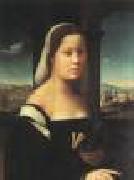 |
BUGIARDINI, Giuliano
|
|
Italian painter, Florentine school (b. 1475, Firenze, d. 1554, Firenze)
Italian painter and draughtsman. He trained in Florence in the workshop of Domenico Ghirlandaio. The influence of Ghirlandaio is apparent in his earliest known works, datable between c. 1495 and 1500, which include part of the altarpiece of the Nativity (Florence, Santa Croce) painted for the Castellani family. Apart from Ghirlandaio, his two most important early influences were Fra Bartolommeo and Mariotto Albertinelli. In 1503 Bugiardini joined the Compagnia di S Luca and began an association with Albertinelli that continued until 1509 when Albertinelli moved to the workshop of Fra Bartolommeo. Bugiardini's paintings of the Virgin and Child (e.g. c. 1510; Kansas City, MO, Nelson-Atkins Mus. A.) show the influence of the balanced classical compositions executed by Raphael in Florence between 1504 and 1508 (e.g. the Madonna of the Meadow, 1505, Vienna, Ksthist. Mus.; La Belle Jardini?re, 1507, Paris, Louvre). From Ghirlandaio's workshop and his study of antique sculpture in the Medici garden, Bugiardini would have known Michelangelo early in his career. Vasari mentioned Bugiardini as among the artists who went to Rome in 1508 to assist Michelangelo with the painting of the ceiling of the Sistine Chapel (Vatican) and who were almost immediately sent back to Florence. The influence of Franciabigio is clear in such works as the Birth of John the Baptist (1512; Stockholm U., Kstsaml.; autograph copy, Modena, Gal. & Mus. Estense) in which nature is not idealized, as compared to contemporary works in Rome. The signed and dated Madonna della palma (Virgin and Child with the Infant John the Baptist, 1520; Florence, Uffizi) suggests his familiarity with such contemporary Roman paintings by Raphael and his workshop as the Madonna of Divine Love (Naples, Capodimonte) or the Madonna of the Rose (c. 1518; Madrid, Prado). |
|
|
|
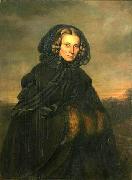 |
C. Grunewald
|
|
paint Portrait of Bertha Wehnert-Beckmann German photographer in 1858 |
|
|
|
|
|
Caillebotte, Gustave
|
|
French Impressionist Painter, 1848-1894
.French painter and collector. Caillebotte's parents, of Norman descent, were wealthy members of the Parisian upper middle class, and his paintings often evoke his family background. After studying classics at the Lyc?e Louis Le Grand, he obtained a law degree in 1870, and during the Franco-Prussian War he was drafted into the Seine Garde Mobile (1870-71). He joined L?on Bonnat's studio in 1872 and passed the entrance examination for the Ecole des Beaux-Arts on 18 March 1873. The records of the Ecole make no mention of his work there, and his attendance seems to have been short-lived. He was very soon attracted by the innovative experiments, against academic teaching, of the young rebels who were to become known as the Impressionists. In 1874 Edgar Degas, whom Caillebotte had met at the house of their mutual friend Giuseppe de Nittis, asked him to take part in the First Impressionist Exhibition at the Nadar Gallery in the Boulevard des Capucines in Paris. However, it was only at the time of their second exhibition in April 1876 that, at Auguste Renoir's invitation, Caillebotte joined the Impressionist group. From then on he was one of the most regular participants in their exhibitions (1877, 1879, 1880, 1882). He organized the show of 1877 and made great efforts to restore the cohesion of the group by persuading Claude Monet to exhibit in 1879. |
|
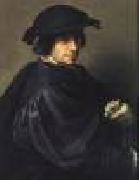 |
CAMPI, Giulio
|
|
Italian Painter, ca.1502-1572
The eldest of a family prominent painters, Campi was born at Cremona. His father Galeazzo (1475-1536) taught him the first lessons in art.
In 1522, in Mantua, he studied painting, architecture, and modelling under Giulio Romano. He visited Rome, became an ardent student of the antique, and like Bernardino ?? distantly related to him ?? he combined a Lombard and Roman traditions. He collaborated on some works with Camillo Boccaccino, the son of Boccaccio Boccaccino, with whom Campi may also have received training.
Campi is called the "Ludovico Carracci of Cremona" although he preceded the founder of the Eclectics. When but twenty-seven Giulio executed for the church of Sant' Abbondio his masterpiece, a Virgin and Child with Sts. Celsus and Nazarus, a decoration masterly in the freedom of its drawing and in the splendour of its colour. His numerous paintings are grandly and reverently conceived, freely drawn, vigorously coloured, lofty in style, and broadly handled. He was animated in all his work by a deep piety. Numerous of his fresco works are housed in churches of Cremona, Mantua, Milan and in the church of Saint Margaret's, in his native town. Among his chief works are the Descent from the Cross (S. Sigismondo) at Cremona, and the frescoes in the dome of S. Girolamo at Mantua. An altar-piece in S. Sigismondo and his Labours of Hercules were engraved by the celebrated Ghiso, il Mantovano.
He died in Cremona in 1572.
|
|
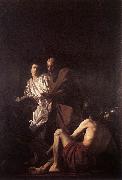 |
CARACCIOLO, Giovanni Battista
|
|
Italian Baroque Era Painter, ca.1578-1635
Italian painter. He was one of the greatest Caravaggesque painters and the founder of Neapolitan Caravaggism. His Liberation of St Peter (c. 1615; Naples, Pio Monte della Misericordia; ) and Christ Washing the Feet of the Disciples (1622; Naples, Certosa di S Martino; see fig. 2 below) are masterpieces of 17th-century Neapolitan art, and attain a powerful and tragic grandeur. |
|
|
|
 |
Carl Gustaf Pilo
|
|
Swedish Painter, 1711-1793,Swedish painter. His father, Olof Pijhlou (1668-1753), was an artist. Pilo may have travelled to Vienna and Germany, and it is probable that he studied at the Drawing Academy established in Stockholm in 1735. From 1737 he was engaged as a portrait painter by members of the southern Swedish aristocracy (e.g. Baron Malte Ramel; evedskloster, priv. col.). About 1740 he settled in Copenhagen, where he swiftly rose to a position of importance: following the enthusiastic reception of his portrait of Louise of England, the wife of the future Frederick V (Copenhagen, Stat. Mus. Kst, on loan to Amalienborg Castle), he was appointed court painter in 1745 and drawing-master to Crown Prince Christian (later Christian VII) in 1759. Pilo was appointed professor at the Royal Academy of Art in Copenhagen in 1748 and for the next two decades was recognized as the foremost portrait painter in Denmark. |
|
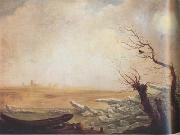 |
Carl Gustav Carus
|
|
German Romantic Painter, 1789-1869
German painter and draughtsman. As well as being an artist, he achieved considerable success as a doctor, a naturalist, a scientist and a psychologist. As an artist, he was concerned almost exclusively with landscape painting, although he never practised it professionally. While still at school in Leipzig, he had drawing lessons from Julius Diez; he subsequently studied under Johann Veit Schnorr von Carolsfeld (1764-1841) at the Oeser drawing academy. From 1813 he taught himself oil painting, copying after the Dresden landscape painter Johann Christian Klengel, whom he visited in his studio. In 1811 after six years at university he graduated as a doctor of medicine and a doctor of philosophy. |
|
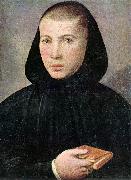 |
CAROTO, Giovanni Francesco
|
|
Italian Painter, 1480-1555
was an Italian painter of the Renaissance, active mainly in his native city of Verona. He initially apprenticed under Liberale da Verona (1445-1526/1529), a conservative painter infused with the style of Mantegna. Caroto after a stay in Milan, began responding to the other influences from Francesco Bonsignori, Leonardo da Vinci, Raphael, and Giulio Romano; but he never lost a certain individuality and his rich Veronese color. He is perhaps best known for having trained, along with the younger Antonio Badile, the prominent Mannerist painter, Paolo Veronese, who was active mainly in Venice. Good examples of his art are in the Castello, Milan, the Chiesa de Carite, Mantua, in the Uffizi and Pitti, Florence, and in the museums of Dresden, Budapest, etc. |
|
 |
CARPI, Girolamo da
|
|
b. 1501, Ferrara, d. 1556, Ferrara
His father Tommaso ( fl 1503-23) was a painter and decorator at the court of the Este in Ferrara, and Girolamo was trained in the workshop of Garofalo. He visited Rome in the early 1520s (Fioravanti Baraldi) and was in Bologna in 1525, where he worked with Biagio Pupini and Giovanni Borghese on the decoration of the sacristy of S Michele in Bosco. Around this time (1525) he painted the altarpiece of the Virgin Enthroned with Saints |
|
|
|
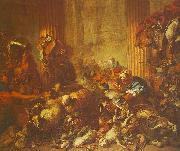 |
CASTIGLIONE, Giovanni Benedetto
|
|
Italian Baroque Era Painter, ca.1609-1664
Painter, printmaker and draughtsman. Most of his works are scenes of the journeys of the patriarchs (e.g. Noah, Abraham, Isaac, Jacob), drawn from the book of Genesis and filled with animals and still-life detail. His oeuvre also, however, includes many spectacular mythological and religious compositions set in expansive landscapes, and for these he found inspiration in Classical mythology, ancient history, Aesop's Fables, 16th-century Italian literature and the lives of the saints. Early biographers claim that he was also a prolific portrait painter, but few examples, save the so-called portrait of Gianlorenzo Bernini (c. 1648-50; Genoa, Pal. Bianco), have been conclusively identified. His surviving subjects reveal his interest in magic and metamorphosis and in philosophical questions such as the frailty of human life, the inevitability of death and the search for truth.
|
|
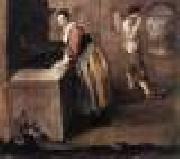 |
CERUTI, Giacomo
|
|
Italian Painter, 1698-1767
Italian painter. He was one of a group of artists working in Bergamo and Brescia who observed reality with an unusual freshness and directness. He painted religious subjects and portraits but was most distinguished as a painter of genre and low-life scenes. These included many pictures of beggars and vagabonds ( pitocchi), hence his nickname 'il Pitocchetto'. He married in Milan in 1717 but settled in Brescia in 1721. In 1723 he received a horse in payment for three altarpieces and four frescoes for the parish church of Rino di Sonico; they were mediocre works executed in an unadventurous blend of Lombard and Venetian traditions derived from contemporary Venetian painters working in Brescia. Ceruti's early portraits and genre scenes are less conventional and more intensely felt; in 1724 he signed and dated the strikingly naturalistic portrait of Giovanni Maria Fenaroli |
|
|
|
|
|
|
|
|
|
|

